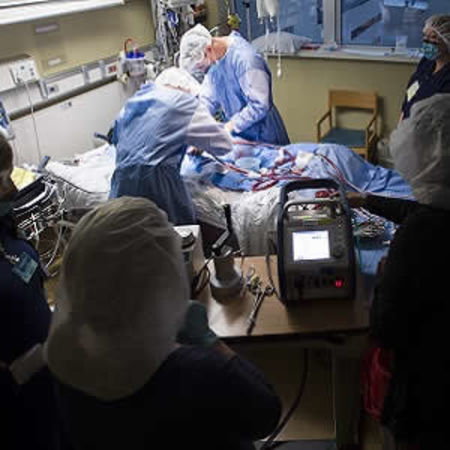The use of extracorporeal life support (ECLS) in adults has grown exponentially in the last decade, fuelled in large part by technological advances in cardiopulmonary bypass equipment, from which ECLS was principally derived. Several specific events also generated much interest in ECLS, including the perceived need for advanced respiratory support in patients with influenza A(H1N1)-associated ARDS during the 2009 pandemic, along with the publication of the Conventional Ventilation or ECMO for Severe Adult Respiratory Failure (CESAR) trial that same year. However, a consensus document to appear in the journal CHEST highlights the lack of strong research data to support ECLS use.
"The current growth of ECLS is outpacing the evidence base supporting its use. For example, in the last decade, only one large randomised clinical trial assessing the efficacy of ECLS for respiratory failure has been published; none has been published for cardiac failure. This lack of data leaves us without definitive answers to a number of important questions, including the most fundamental: When is ECLS indicated? Also, is it superior to the best current standard of care?," according to article authors.
This paucity of data is attributed to the difficulty in performing clinical trials in this field. Of note, ECLS practices are very heterogeneous across centres. Sources of this heterogeneity include the equipment used, circuit configurations, methods of weaning, protocols for anticoagulation, the use of retrieval from other hospitals, and the range of underlying diseases for which it is used, explain the authors. Another major challenge for researchers is that the patients are often very ill, with short time-windows for study enrolment. In addition, there are external factors, such as institutional prestige, industry influence, and family requests, that drive the use of ECLS and compete with research for influence over the direction of the field. Given these challenges, the authors call for developing a strategy to strengthen the evidence base in ECLS.
"Evidence is required because ECLS is complex, expensive, high risk, and resource intense. We need to clarify whether ECLS should be applied at all and, if so, how early in the clinical course it should be initiated; which patients benefit most; and exactly what complications to expect with different devices or techniques, informing the risk-to-benefit ratio of using ECLS in various clinical settings," the authors write.
Successful research in ECLS, according to the authors, will require collaboration among centres, across regions, countries, and continents. It will also require collaboration across medical disciplines. "The ECLS community must come together to decide on research priorities and collaborate on high-quality research," they point out. In this regard, the use of existing research networks and medical societies to design and conduct research will be important, as will the creation of research networks dedicated specifically to the study of ECLS, which facilitate such collaboration within the field.
These networks (e.g., the International ECMO Network) and major organisations (e.g., the Extracorporeal Life Support Organisation) would be helpful in bringing consensus to definitions and nomenclature, as well as defining clinical standards for ECLS delivery. Further, the authors say, the development and use of common research databases and registries should be considered obligatory for centres using ECLS for participation in research or, at a minimum, for quality assurance.
"Importantly, in the setting of clinical trials, we must take care to protocolise the ECLS practices. If efficacy is established, we will then be able to coalesce around those elements of the protocol most closely linked to the benefits seen. In doing so, we can begin to illuminate a set of best practices for clinical care in ECLS," the authors explain.
Until such information is available, the authors say clinicians should consider restricting the use of ECLS to cases of refractory cardiopulmonary failure and, even then, only after applying conventional evidence-based practices, as appropriate. The use of extracorporeal carbon dioxide removal for COPD or less-than-severe cases of ARDS, for instance, should be restricted to the research setting until we understand the risk-to-benefit ratio and can show the value of this therapeutic approach, they add.
Source: CHEST
Image Credit: Air Force 59th Medical Wing
References:
Brodie D et al. on behalf of the International ECMO Network (ECMONet)
(2018) Research in extracorporeal life support: a call to action. CHEST doi: https://doi.org/10.1016/j.chest.2017.12.024
Latest Articles
ECLS, extracorporeal life support, advanced respiratory support, influenza A(H1N1)-associated ARDS
The use of extracorporeal life support (ECLS) in adults has grown exponentially in the last decade, fuelled in large part by technological advances in cardiopulmonary bypass equipment, from which ECLS was principally derived. Several specific events also



























